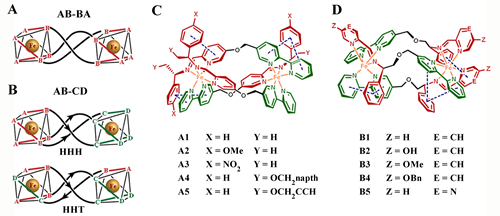
Alzheimer’s disease (AD), the most prevalent age-related dementia, affects more than 30 million people worldwide. The origin of neurotoxicity is closely linked to the amyloid β (Aβ) aggregation in AD pathogenesis. Emerging evidence suggests that stabilization of Aβ helical motif may be a suitable target for inhibiting Aβ aggregation.
Certain self-assembling chiral multimetallic coordination complexes, named helicates, have similar size to α-helical peptides, particularly in terms of their diameter and charge, and this can lead to specific target-binding affinity with biomolecules. Therefore, chiral supramolecules which are capable of binding the α-helical form may selectively inhibit Aβ aggregation.
Dr. QU Xiaogang from Changchun Institute of Applied Chemistry (CIAC) of the Chinese Academy of Sciences and his collaborators took a new strategy whereby directional ligands AB–CD are used to synthesize optically pure head-to-head-to-tail (HHT) asymmetric constitutions in the absence of head-to-head-to-head (HHH) isomers (Fig. B) and strategically prepared a highly stereoselective self-assembly of diverse.
They found that these metallohelices with the HHT structure could enantioselectively inhibit Aβ aggregation by using a live cell-based high-throughput screening system.
These chiral metallohelices have amphipathic topology and high, structure-dependent, selective biological activity. The Λ- enantiomer specifically targets the central hydrophobic α/β discordant stretch and shows much stronger effect on inhibition of Aβ 42 aggregation than the Δ-enantiomers, which was evidenced by multiple biophysical and biochemical techniques, NMR spectroscopy, FTIR and molecular simulations studies.
More intriguingly, Aβ can cause signaling amplification that inactivates superoxide dismutase (SOD) and generates additional free radicals.
They also found that the metallohelicate has SOD activity as an artificial enzyme to further deplete cytotoxic superoxide (O2−) radicals. Further studies demonstrated that these metallohelices could cross the blood-brain barrier (BBB) and block Aβ-mediated cellular toxicity.
In vivo studies prove that these metallohelices extend the life span of AD model C. elegans CL2006 strain by attenuating Aβ-induced toxicity.
This work, published in Science Advances, indicates that these new generations of asymmetric chiral supramolecular complexes are novel potent Aβ inhibitors for AD treatment.

Figure (A) Symmetric metallohelices based on rigid ditopic bidentate ligands AB-BA give D3-symmetric enantiomers [Fe2(AB-BA)3]. (B) The directional ligands AB-CD lead to C1-symmetric HHH and HHT “triplex” architectures. (C and D) Metallohelices self-assembled from various components of a range of functionalized helices with HHT structure. Me, methyl; napth, naphthyl; Bn, benzyl. (Image by QU Xiaogang)

86-10-68597521 (day)
86-10-68597289 (night)

86-10-68511095 (day)
86-10-68512458 (night)

cas_en@cas.cn

52 Sanlihe Rd., Xicheng District,
Beijing, China (100864)

